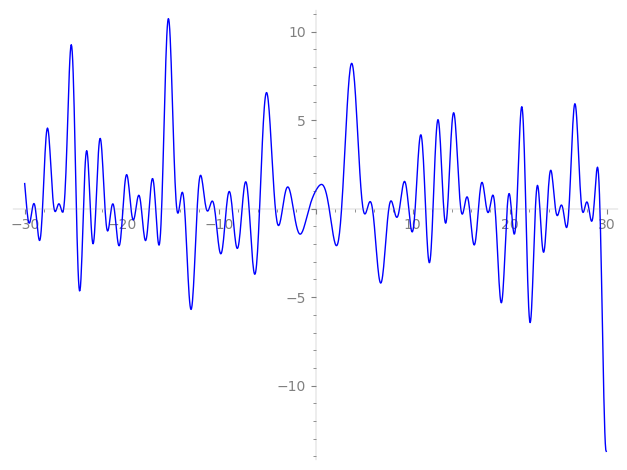| L(s) = 1 | + (−0.909 − 1.08i)2-s + (−0.347 + 1.96i)4-s + (0.388 + 2.20i)5-s + (1.78 − 3.08i)7-s + (2.44 − 1.41i)8-s + (−2.29 − 1.92i)9-s + (2.03 − 2.42i)10-s + (−2.79 − 4.84i)11-s + (2.29 + 6.29i)13-s + (−4.96 + 0.874i)14-s + (−3.75 − 1.36i)16-s + 4.24i·18-s + (4.33 + 0.494i)19-s − 4.47·20-s + (−2.70 + 7.43i)22-s + (1.23 − 6.99i)23-s + ⋯ |
| L(s) = 1 | + (−0.642 − 0.766i)2-s + (−0.173 + 0.984i)4-s + (0.173 + 0.984i)5-s + (0.673 − 1.16i)7-s + (0.866 − 0.500i)8-s + (−0.766 − 0.642i)9-s + (0.642 − 0.766i)10-s + (−0.843 − 1.46i)11-s + (0.635 + 1.74i)13-s + (−1.32 + 0.233i)14-s + (−0.939 − 0.342i)16-s + 0.999i·18-s + (0.993 + 0.113i)19-s − 0.999·20-s + (−0.577 + 1.58i)22-s + (0.257 − 1.45i)23-s + ⋯ |
\[\begin{aligned}\Lambda(s)=\mathstrut & 760 ^{s/2} \, \Gamma_{\C}(s) \, L(s)\cr =\mathstrut & (-0.113 + 0.993i)\, \overline{\Lambda}(2-s) \end{aligned}\]
\[\begin{aligned}\Lambda(s)=\mathstrut & 760 ^{s/2} \, \Gamma_{\C}(s+1/2) \, L(s)\cr =\mathstrut & (-0.113 + 0.993i)\, \overline{\Lambda}(1-s) \end{aligned}\]
Particular Values
| \(L(1)\) |
\(\approx\) |
\(0.671593 - 0.753063i\) |
| \(L(\frac12)\) |
\(\approx\) |
\(0.671593 - 0.753063i\) |
| \(L(\frac{3}{2})\) |
|
not available |
| \(L(1)\) |
|
not available |
\(L(s) = \displaystyle \prod_{p} F_p(p^{-s})^{-1} \)
| $p$ | $F_p(T)$ |
|---|
| bad | 2 | \( 1 + (0.909 + 1.08i)T \) |
| 5 | \( 1 + (-0.388 - 2.20i)T \) |
| 19 | \( 1 + (-4.33 - 0.494i)T \) |
| good | 3 | \( 1 + (2.29 + 1.92i)T^{2} \) |
| 7 | \( 1 + (-1.78 + 3.08i)T + (-3.5 - 6.06i)T^{2} \) |
| 11 | \( 1 + (2.79 + 4.84i)T + (-5.5 + 9.52i)T^{2} \) |
| 13 | \( 1 + (-2.29 - 6.29i)T + (-9.95 + 8.35i)T^{2} \) |
| 17 | \( 1 + (-2.95 + 16.7i)T^{2} \) |
| 23 | \( 1 + (-1.23 + 6.99i)T + (-21.6 - 7.86i)T^{2} \) |
| 29 | \( 1 + (5.03 + 28.5i)T^{2} \) |
| 31 | \( 1 + (-15.5 - 26.8i)T^{2} \) |
| 37 | \( 1 + 12.1iT - 37T^{2} \) |
| 41 | \( 1 + (-3.75 + 10.3i)T + (-31.4 - 26.3i)T^{2} \) |
| 43 | \( 1 + (40.4 - 14.7i)T^{2} \) |
| 47 | \( 1 + (-3.26 - 2.73i)T + (8.16 + 46.2i)T^{2} \) |
| 53 | \( 1 + (-12.0 - 2.12i)T + (49.8 + 18.1i)T^{2} \) |
| 59 | \( 1 + (5.76 + 6.86i)T + (-10.2 + 58.1i)T^{2} \) |
| 61 | \( 1 + (57.3 + 20.8i)T^{2} \) |
| 67 | \( 1 + (11.6 + 65.9i)T^{2} \) |
| 71 | \( 1 + (-66.7 + 24.2i)T^{2} \) |
| 73 | \( 1 + (-55.9 - 46.9i)T^{2} \) |
| 79 | \( 1 + (60.5 + 50.7i)T^{2} \) |
| 83 | \( 1 + (41.5 + 71.8i)T^{2} \) |
| 89 | \( 1 + (2.42 + 6.66i)T + (-68.1 + 57.2i)T^{2} \) |
| 97 | \( 1 + (16.8 - 95.5i)T^{2} \) |
| show more | |
| show less | |
\(L(s) = \displaystyle\prod_p \ \prod_{j=1}^{2} (1 - \alpha_{j,p}\, p^{-s})^{-1}\)
Imaginary part of the first few zeros on the critical line
−10.42488403130856756148505137032, −9.217296503131872082545073266042, −8.603940144425325867333282077170, −7.59015914199178224754178049699, −6.86678414220252837854218805241, −5.78550037653923271405164544788, −4.15892049871446081317364712503, −3.42413139449148662964160521052, −2.31186611927435139928522547089, −0.69350796001639810273579754387,
1.38948167683195199789938913870, 2.66491015117430734220866840721, 4.87646338431729115866497024553, 5.31212377104086581334989892671, 5.84481644164940071571454474274, 7.53203263912690976611775046919, 8.048378868844640526030027427098, 8.634453742494030640289426891215, 9.585264172344208605987648615859, 10.24981997654312333629308172723

